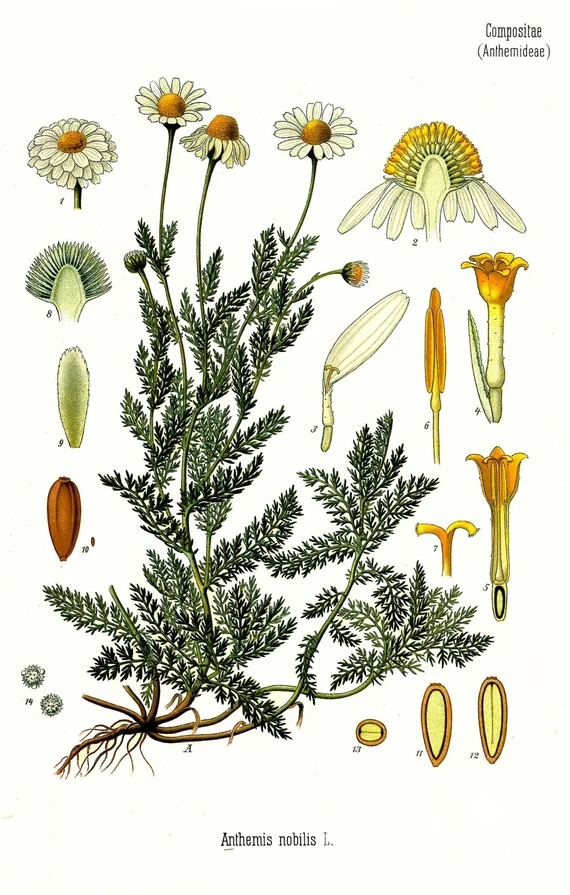Common Name: Roman Chamomile
Scientific Name: Chamaemelum nobile
Areas of the United States Found in Nature
Roman Chamomile is often found in gardens and can naturalize in open areas, along paths, and in fields throughout the United States. It prefers well-drained soils and full sun but can tolerate partial shade. It is commonly grown as a ground cover or in herb gardens for its fragrant flowers and medicinal uses.
How to Identify It
Roman Chamomile is a low-growing, creeping perennial herb that forms a dense mat. It has feathery, finely divided leaves that are bright green and aromatic when crushed. The plant produces small, daisy-like flowers with white petals and a yellow center, similar in appearance to a miniature daisy. The flowers bloom from early summer to fall and emit a sweet, apple-like fragrance.
How and When to Harvest for the Highest Medicinal Value
Harvest Roman Chamomile flowers when they are fully open, usually in early to mid-summer. Cut the flowers in the morning after the dew has dried, using scissors or your fingers. Harvest regularly to encourage continued blooming throughout the season.
How to Preserve the Herb for Future Use
Roman Chamomile can be used fresh or dried:
Drying
Spread the flowers out in a single layer on a drying rack in a dark, cool, and well-ventilated area, or use a dehydrator on a low setting. Once dry, store the flowers in airtight containers away from light and moisture. Properly dried Chamomile can be stored for up to a year.
Freezing
Fresh Chamomile flowers can be frozen by placing them in ice cube trays with water. Freeze and then transfer the cubes to a sealed container for later use in teas or baths.
Medicinal Uses
Roman Chamomile is known for its calming, anti-inflammatory, and digestive properties. It is often used to reduce anxiety, aid sleep, and soothe digestive issues. It is also used topically for skin irritations and minor wounds.
Tea
Steep 1-2 teaspoons of fresh or dried Roman Chamomile flowers in hot water for 10-15 minutes. Chamomile tea can help with relaxation, improve sleep, reduce anxiety, and relieve digestive discomfort.
Infused Oil
Infuse fresh Chamomile flowers in a carrier oil like olive or coconut oil for several weeks, then strain. This infused oil can be used topically to soothe irritated skin, reduce inflammation, and promote healing.
Bath
Add a handful of fresh or dried Chamomile flowers to a warm bath. The soothing aroma and anti-inflammatory properties can help relax the body and mind while softening the skin.
How to Propagate for Annual Use in Your Garden
Roman Chamomile can be propagated from seeds, cuttings, or by division.
From Seed
Sow Chamomile seeds directly in the garden in early spring or late summer. The seeds should be lightly covered with soil, as they require light to germinate. Keep the soil moist until germination, which typically occurs within 7-14 days.
By Cuttings
Take cuttings from healthy Roman Chamomile plants in late spring or early summer. Remove the lower leaves, dip the cut end in rooting hormone, and plant the cutting in a pot with well-drained soil. Keep the cuttings in a shaded area until they root, then transplant them into your garden.
By Division
Divide mature Chamomile plants in the spring or fall. Dig up the plant and gently separate the roots into smaller sections, each with some stems. Replant the divisions at the same depth they were growing before, spacing them about 8-12 inches apart. Water well after planting.
How to Over-Winter the Plant
Roman Chamomile is hardy and can survive winter in most regions without special care.
Cut Back
After the first frost or once the plant has fully died back in late fall, trim the stems to about 2-3 inches above the ground. This helps prevent any disease and tidies up the garden.
Mulch
Apply a light layer of mulch, such as straw or shredded leaves, around the base of the plant after the ground begins to freeze. This helps insulate the roots and protect them from severe cold and temperature fluctuations.
Watering
Reduce watering during the winter months, as Roman Chamomile goes dormant and does not need as much water. Ensure the soil remains well-draining to prevent root rot.
In the spring, remove any mulch and allow new growth to emerge naturally. Roman Chamomile will regrow from its roots and continue to provide its fragrant flowers and medicinal benefits in your garden.

